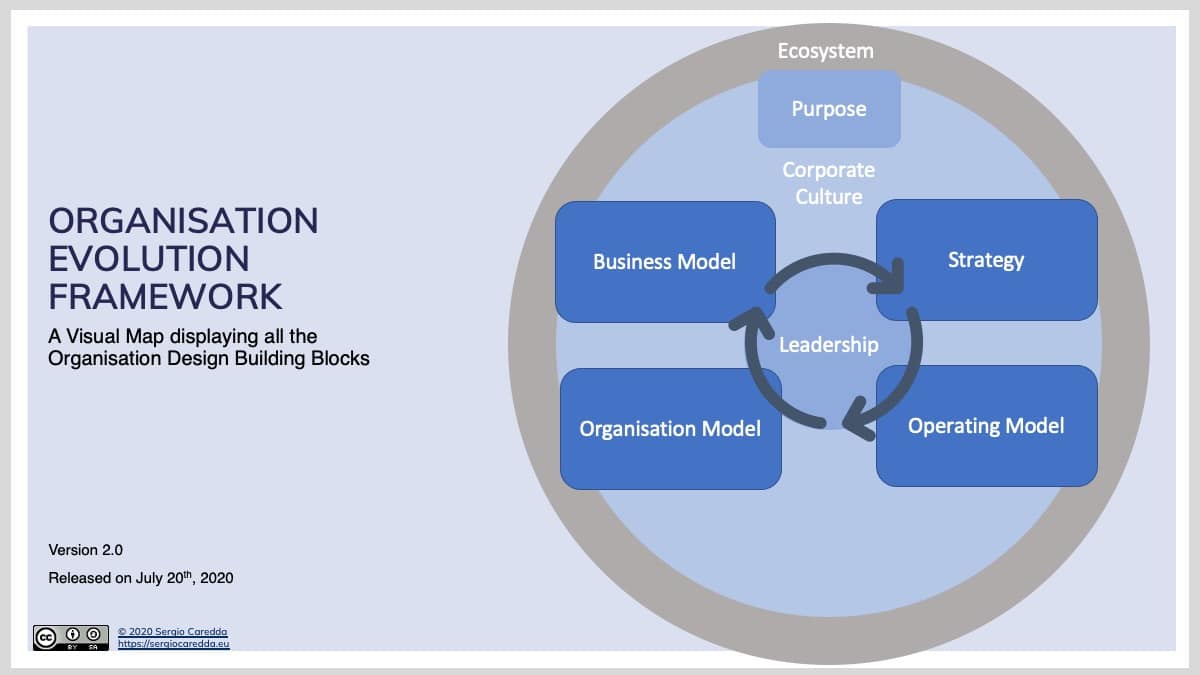I’ve received an email from a University Student who read my article What is Organisation Design? From the email, I understood that he had some confusion on some terms often used interchangeably in many articles, especially on the web. So I wanted to help in Understanding Models by shedding some light and trying to provide some definitions for each element. I found some compelling descriptions in a post of Naomi Stanford that I will use to elaborate from (Stanford, 2016).
Understanding Models: a List
- Business Model. It is the definition of what you are offering (product or service) how and to whom. I’ve now dedicated a long post to Business Models Theory.
- Strategy. It is the direction and scope over the coming period to activate the business model. We have already explored in detail what Strategy is.
- Operating Model. These are the key’ tactical’ components, e.g. systems, process, people and the technology which will deliver the strategy. I have now dedicated a long analysis of the existing models.
- Organisation Model. This is the work that people are doing within and across the key components of the Operating Model, and how are these people organised to do the work efficiently, effectively, and with enjoyment. I’ve already done a long post which reviews most existing theoretical Organisation Models, although I have also mentioned that each organisation needs to find its own one. Note: an Organisation Chart can help understand what is the Organisation Model, but it’s not sufficient alone, as it is essential also to consider elements like operational governance.
How do you define these models? An essential discipline is Organisation Design which is traditionally focused on the last aspect (but can often support also the definition of the Operating Model). In any case, Business Model and Strategy usually are inputs for the Org Design process. The fact that sometimes we use standard tools (for example, Design Thinking Workshops) for each of these components is probably part of the reason why there tends to be confusion.
An alternative view.
An interesting note to add: Deloitte in a recent article introduces a model (Kwan, Schroeck and Kawamura, 2019) (seen in Figure 1) which adds an additional component to the four listed above: Capabilities, and inverts the roles of Strategy and Business Model, although the definitions are not fully matching (Andrew Campbell, 2019).

The concept of Capabilities is probably worth exploring further because what the article suggests is to essentially anticipate a key focus area of Strategic Workforce Planning. Capability is defined as a discrete set of objectives, processes, technologies, and talent that collectively generate value for an organization (Kwan, Schroeck and Kawamura, 2019). I appreciate the idea that capability is explored ahead of the Operating Model, becoming an input. I have covered this more in detail in the article related to this subject, and will probably check more in the future the concept of Capabilities Maps vs Value Chains.
How do we get from Business Model to the Organisation?
This is also where confusion still exists. Multiple tools help in the definition of a Business Model, and these are often used also as the first step for Organisation Design (Naomi Stanford covers the most known of these in her Guide to Organisation Design). Why this? Well, the reason is simple: in many cases when you are approaching an organisation issue, you need to ensure there is clarity around the Business Model and the Strategy of an organisation, something that is not always necessarily true.
Start with the Business Model
There is also much confusion between Business Model and Operating Model (Stanford, 2010). Tim Kastelle did build a list of Business Model Tools (Kastelle, 2012) and framed their importance, also pointing out at different ways these can be used for.
The business model of a company is a simplified representation of its business logic. It describes what a company offers its customers, how it reaches them and relates to them, through which resources, activities and partners it achieves this and finally, how it earns money.
Alex Osterwalder, How to Describe and Improve your Business Model to Compete Better
I especially like the first suggestion that Kastelle’s delivers, which is that of using a Business Model to test the validity of your Organisation Design, as what you need to ensure is that consistency is reached. This is very much in line with an old concept, called Contingency Theory, which essentially claims that there is no single best way to design organisational structures. The best way of organising, e.g. a company, is, however, contingent upon the internal and external situation of the company.
This is the main reason why Business Models matter, which boils down mainly to the fact that they compel an enterprise to make choices. And this is also the reason why this should be the first step for an organisation. I find the Business Model Canvas a tool particularly friendly to help out with this task.
An alternative tool is the Platform Design Toolkit which enables the exploration of Platform-based Business Models, which seem to be set for real success in today’s economy. As a matter of fact, traditional Business Model frameworks are being challenged today by Ecosystems’ ones. I have now put together a view on the multiple theories on Business Models.
Note: to add to the confusion, there are a plethora of other “things” that seem to overlap heavily with the Business Model or Strategy Definition. Vision, Mission, Purpose, Value Proposition, Employee Value Proposition, Sustainability, Impact Framework…. I’m sure you can for sure add some more. In most cases, these, however, align to some specific communication needs but don’t necessarily encompass the entire Business Model content.
Design the Strategy
Strategy comes second and normally has a limited span of time (3 to 5 years). We have already spoken of it in detail.
Build the Operating Model

Operating Model is the third component. Some have defined them Tactics in the past to underline the distinction with strategy (but also a hint to the Military Tradition of splitting Strategy and Tactics) (Casadesus-Masanell and Joan Enric Ricart, 2010). Creating an Operating Model is a work that is similar to creating the information system architecture that IT systems need to perform. And I believe that Enterprise Architecture is the nearest proxy to specify what an Operating Model is. Which is also why the definition of an Operating Model is key in a Digital Transformation (Kwan, Schroeck and Kawamura, 2019).
An operating model represents how value is created by an organization—and by whom within the organization.
Deloitte, Architecting an operating model (Kwan, Schroeck and Kawamura, 2019)
Also here there are different tools available, and I find the POLISM Operating Model Canvas particularly user-friendly.
Note: another word of caution. In consulting jargon, we often read the name Target Operating Model (or TOM). What is it? In theory, it is the model that is defined as the goal of a change programme or transformation process. Unfortunately, sometimes this is limited to one domain only (often technology).
Design the execution through the Organisation Model
Fourth Step in Understanding Models is the creation of the Organisation Model. We use here the tools of Organisation Design, with the focus to really build consistency (as already mentioned). We have previously referenced Nicolay Worren’s blog: What is organisation design, as it provides an excellent reference framework (Worren, 2015). I’ve recently shared a post on the different Organisation Model that exist and are used, with particular reference to New Human Centered Models.
A new answer: the Organisation Evolution Framework
I’ve recently introduced a Visual Framework that allows visualising all essential building blocks of Organisation Design. The Version one is available and open for feedback and hopefully gives a better clarity on what exactly each block is and represents. Note that I have added other elements to it than the 4 identified in this article.

Introducing the Organisation Evolution Framework
Visual representation of Organisation Design building blocks and their dynamic relationships.
Now released in Version 1, open for feedback.
Conclusion: It is a Matter of Intentional Design
As with all other elements listed here, there’s never a possibility to copy and paste someone else model or adopt a template. Everything needs to be intentionally and purposefully designed around the specificity of each organisation. Everything needs to be intended as an act of Intentional Design aimed at connecting the reason why the organisation exists with its performance and results. This articulates the need for an additional aspect: the Purpose. Reason for it is that it becomes the reason for why an intentional design focus needs to be started.
How does this relate to the current Change we are living in? I believe that the most significant transformative element is that for many years we could design all of the above aspects without necessarily considering the Customer of the organisation. With the adoption of Design Thinking Principles, we should now embed the customers in each and every Model Design Process. A challenge worth taking, also because it will create a much more synergic process in the redesign of all the elements mentioned in this post.
What do you think? Are the definitions of these elements now more explicit? Did it help in Understanding Models, or something missing? Feel free to comment in the form below.

Cover Photo by Daniel van den Berg on Unsplash




Sergio, I love this post. It’s quite a chapter of a book.
A few thoughts I’d like to add are:
1. Purpose to me is not just another layer, it’s the north star. It’s the chaotic attractor. It’s the beacon. The reason to exist that should drive the business model, the strategy, the operating model, the organization design. Only with this level of consistency the firm is constantly achieving its maximum potential.
2. For how much I’m into that, the huge novelty that has been emerging on the market for the last 5 – 10 years (and in literature for much more than that) is not just human centric ODs but the ability for the organization to constantly modify itself in line with its nature of a human complex adaptive system. This is the quantum leap from getting it right once in one part of the organization to getting it right all the time in every part of the organization because each individual, team, unit / function / division can constantly feel tensions and be empowered to act on them not only at tactical levels (the resulting actions) but in terms of changing the design. This is what Holacracy does with lots of burden. The same happens with Sociocracy with much less monolithic thinking and overstructure.
3. Interestingly enough, the same is true for organizational change: the idea of una-tantum change initiatives is anachronistic. There is no A and B. There is no longer a starting and an end-point of transformation cause there is no transformation, only continuous evolution. It’s a fluid process with different results in different parts of the organization, at different times, in which all employees should play a crucial role (that also means the traditional idea of a centralized, top-down strategy is over but that’s another post..)
The conclusion of all this is that not just ready-made models won’t ever work but also that any (custom-made) model won’t work either as long as we imagine it as a single scheme that somebody could design once and for all (even it that means 6 months) for the entire organization by considering him/herself outside from it.
What works and scales (again another post) smoothly is considering the organization for what it is, a human complex adaptive system. You cannot design a living thing. You cannot manage it. Yes you can look for leverage points but most of all you must dance with the system to nurture it to evolve itself towards its own evolutionary purpose in a non-linear, unpredictable, emergent way.
Ciao Emanuele,
Thanks a lot for the extensive feedback.
Also totally agree with your conclusion. And my next post on this topic will try to add one further point of view, on how to make OD a dynamic process.
Ciao!
Hi Sergio,
Based on all the content presented in this article, it appears to me that there is single CONTEXT that needs to be recognized and addressed. And that context is… HOW BEST TO GO ABOUT DESIGNING and CONSTRUCTING and ultimately OPERATING a VIABLE [SOCIO-TECHNICAL] SYSTEM; in this case, in the form of a man-made organization. And what’s being covered via the use of DIFFERENT MODELS is actually nothing more that viewing the SYSTEM-OF-INTEREST from different PERSPECTIVES. Ultimately, each perspective needs to be a representation of the same SYSTEM-OF-INTEREST.
So, with that thought in mind, the questions that actually needs to be asked (and answered) would logically fall into the following sequence:
1) What would be the underlying INTENT/REASON-FOR-BEING/PURPOSE for a particular SYSTEM-OF-INTEREST?
2) What are the sorts of CORE/DISTINCTIVE COMPETENCIES AND COMPETITIVE CAPABILITIES that would be necessary in order to most efficiently and effectively (and maybe even joyfully) pursue fulfulling that INTENT?
3) Given the required COMPETENCIES AND CAPABILITIES, what are the various ways that those COMPETENCIES AND CAPABILITIES can be constituted/assembled and what are likely to be the most viable combinations?
4) What kind of ADAPTIVE/EVOLUTIONARY mechanisms (i.e., people, processes, technologies, policies/procedures/practices/protocols, etc.) need to be institutionalized in order to ensure the on-going sustainability a viable system/organization?
Thank you Jay for your comment.
I had to go around and scout a bit the web for a definition of “System-of-Interest”, and I tend to agree to your points. With one caveat: I’m unsure there is “one best way” to go about designing and building a system, but rather there are different “good” ways, depending on how you examine the environment, and how you balance the components of the system.
Your sequence of questions seems correct and logical. Again, my doubt is if we can always follow completely such a step-by-step approach. It’s easy when you are forming an organisation from scratch, much more difficult when you have to change an existing organisation.
I’m very interested on your last point: what would you suggest such Adaptive/Evolutionary mechanisms can be? Can you elaborate a bit more?
Cheers
Sergio
[…] Understanding Models: Business, Strategy and Organisation. […]
[…] have recently started endeavour in trying to define the essential elements of the design fabric of an organisation. Business Models are a crucial element of this definition, together with Strategy, […]
[…] quite some interest and discussion. I had at the same written and scheduled a post that wanted to try to bring some clarity on the more common “models” we use when speaking a…. What also connects these two posts is the absolute need to think in terms […]
[…] At the end of the book, the author builds a list of Thoughts for Managing a Creative Culture. Inspired from that, here is a slightly adapted and commented list, which also takes from other external inspiration and tries to link to other concepts we have explored in this blog. Developing a Creative Culture becomes a way to ensure the required consistency with all the other organisation elements. […]
[…] Understanding Models: Business, Strategy and Organisation. […]
[…] Understanding Models: Business, Strategy and Organisation. […]
[…] Understanding Models: Business, Strategy and Organisation. […]
[…] Understanding Models: Business, Strategy and Organisation. […]
[…] Understanding Models: Business, Strategy and Organisation. […]
[…] Understanding Models: Business, Strategy and Organisation. […]
[…] this post, I explore the third element of the Organisation Design Blocks that we have mentioned, and that constitutes a foundational element of the Organisation Evolution […]
[…] focused on structuring a few organisation design concepts on this blog. I tried to clarify the distinction between Business Model, Strategy, Operating Model and Organisation Model. I have spoken about Consistency and Intentional Design. I have done a deep dive on […]
[…] have recently started endeavour in trying to define the essential elements of the design fabric of an organisation. Business Models are a crucial element of this definition, together with Strategy, Operating […]
[…] interest and discussion. I had at the same written and scheduled a post that wanted to try to bring some clarity on the more common “models” we use when speaking about organisations: Business Model, Strategy, Operating Model and Organisation […]